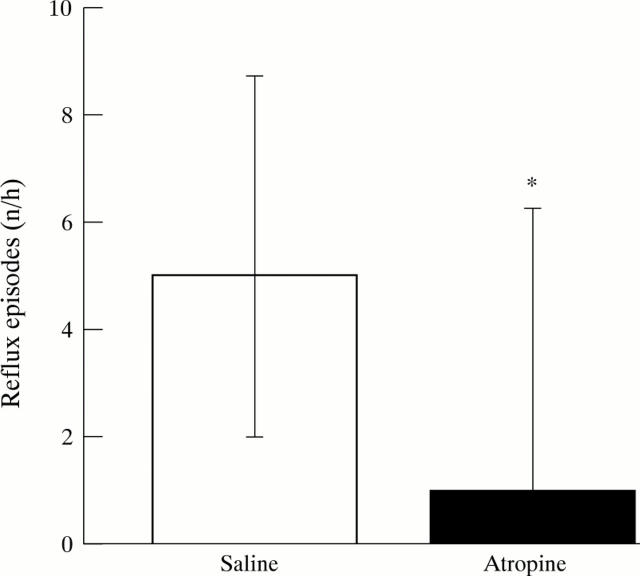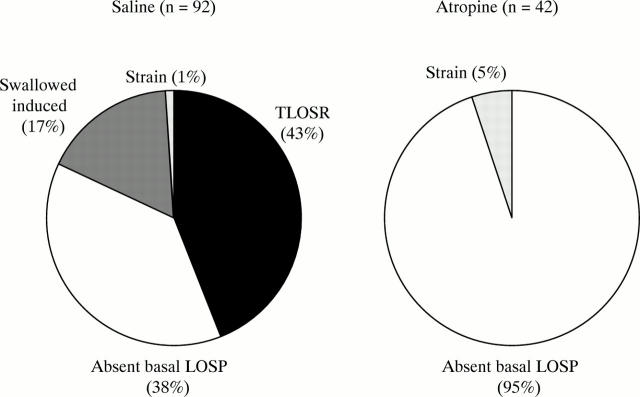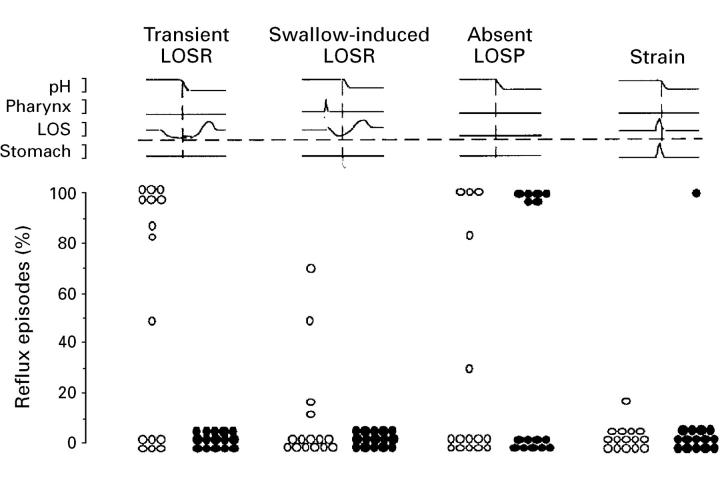Abstract
Background—Atropine reduces the rate of reflux episodes in normal subjects by inhibition of transient lower oesophageal sphincter (LOS) relaxations. The aim of this study was to investigate the effect of atropine on the rate and mechanisms of reflux in patients with reflux disease. Methods—Oesophageal motility and pH were recorded for one hour after a meal in 15 patients with reflux disease. On separate days, atropine (15 µg/kg bolus intravenously, 4 µg/kg/h infusion) or saline were given and maintained for the recording period. Results—Atropine significantly reduced basal LOS pressure from 7.1 (2.2) to 2.9 (1.3) mm Hg (mean (SEM)). Atropine also reduced the rate of reflux episodes from 5.0 (2.0-8.75) to 1.0 (0-6.25) per hour (median (interquartile range)) largely because of a decrease in the rate of transient LOS relaxations from 2.0 (0-4.75) to 0 (0-0) per hour and abolition of reflux during swallow induced LOS relaxation. There was no change in the rate of reflux episodes because of absent basal LOS pressure. Conclusions—Atropine inhibits reflux in patients with reflux disease largely by inhibition of transient LOS relaxations and swallow induced LOS relaxation. These findings suggest that pharmacological control of reflux through control of transient LOS relaxations is possible in patients with reflux disease.
Keywords: gastro-oesophageal reflux; lower oesophageal sphincter; manometry; diaphragm; atropine; pharmacology
Full Text
The Full Text of this article is available as a PDF (118.4 KB).
Figure 1 .
Effect of atropine on lower basal oesophageal sphincter (LOS) pressure. Data have been grouped into intervals of pressure and are expressed as a percentage of the total recording time. Atropine significantly increased the proportion of time that LOS pressure was 2 mm Hg or less. *p<0.05 v control (saline infusion). Open columns, saline; closed columns, atropine.
Figure 2 .
Effect of atropine on the number of reflux episodes. Data are depicted as median (interquartile range). *p<0.05 v control (saline infusion).
Figure 3 .
Mechanism of reflux during saline and atropine infusion. The data for each group have been pooled and the numbers in parentheses indicate the percentage of reflux episodes. LOSP, lower oesophageal sphincter pressure; TLOSR, transient LOS relaxation.
Figure 4 .
Effect of atropine on the mechanism of reflux. Each point represents the proportion of reflux episodes in an individual patient that is attributable to a particular mechanism. LOSR, lower oesophageal sphincter relaxation; LOSP, lower oesophageal sphincter pressure. Open circles, saline; closed circles, atropine.
Figure 5 .
Effect of atropine on the number of transient lower oesophageal sphincter relaxations (TLOSRs). The data are depicted as median and interquartile range. *p<0.01 v control (saline infusion).
Selected References
These references are in PubMed. This may not be the complete list of references from this article.
- Chakraborty T. K., Ogilvie A. L., Heading R. C., Ewing D. J. Abnormal cardiovascular reflexes in patients with gastro-oesophageal reflux. Gut. 1989 Jan;30(1):46–49. doi: 10.1136/gut.30.1.46. [DOI] [PMC free article] [PubMed] [Google Scholar]
- Cunningham K. M., Horowitz M., Riddell P. S., Maddern G. J., Myers J. C., Holloway R. H., Wishart J. M., Jamieson G. G. Relations among autonomic nerve dysfunction, oesophageal motility, and gastric emptying in gastro-oesophageal reflux disease. Gut. 1991 Dec;32(12):1436–1440. doi: 10.1136/gut.32.12.1436. [DOI] [PMC free article] [PubMed] [Google Scholar]
- Dent J., Dodds W. J., Friedman R. H., Sekiguchi T., Hogan W. J., Arndorfer R. C., Petrie D. J. Mechanism of gastroesophageal reflux in recumbent asymptomatic human subjects. J Clin Invest. 1980 Feb;65(2):256–267. doi: 10.1172/JCI109667. [DOI] [PMC free article] [PubMed] [Google Scholar]
- Dent J., Holloway R. H., Toouli J., Dodds W. J. Mechanisms of lower oesophageal sphincter incompetence in patients with symptomatic gastrooesophageal reflux. Gut. 1988 Aug;29(8):1020–1028. doi: 10.1136/gut.29.8.1020. [DOI] [PMC free article] [PubMed] [Google Scholar]
- Dodds W. J., Dent J., Hogan W. J., Arndorfer R. C. Effect of atropine on esophageal motor function in humans. Am J Physiol. 1981 Apr;240(4):G290–G296. doi: 10.1152/ajpgi.1981.240.4.G290. [DOI] [PubMed] [Google Scholar]
- Dodds W. J., Dent J., Hogan W. J., Helm J. F., Hauser R., Patel G. K., Egide M. S. Mechanisms of gastroesophageal reflux in patients with reflux esophagitis. N Engl J Med. 1982 Dec 16;307(25):1547–1552. doi: 10.1056/NEJM198212163072503. [DOI] [PubMed] [Google Scholar]
- Dow T. G., Brock-Utne J. G., Rubin J., Welman S., Dimopoulos G. E., Moshal M. G. The effect of atropine on the lower esophageal sphincter in late pregnancy. Obstet Gynecol. 1978 Apr;51(4):426–430. doi: 10.1097/00006250-197804000-00009. [DOI] [PubMed] [Google Scholar]
- Fisher R. S., Malmud L. S., Roberts G. S., Lobis I. F. The lower esophageal sphincter as a barrier to gastroesophageal reflux. Gastroenterology. 1977 Jan;72(1):19–22. [PubMed] [Google Scholar]
- Hetzel D. J., Dent J., Reed W. D., Narielvala F. M., Mackinnon M., McCarthy J. H., Mitchell B., Beveridge B. R., Laurence B. H., Gibson G. G. Healing and relapse of severe peptic esophagitis after treatment with omeprazole. Gastroenterology. 1988 Oct;95(4):903–912. doi: 10.1016/0016-5085(88)90162-x. [DOI] [PubMed] [Google Scholar]
- Holloway R. H., Penagini R., Ireland A. C. Criteria for objective definition of transient lower esophageal sphincter relaxation. Am J Physiol. 1995 Jan;268(1 Pt 1):G128–G133. doi: 10.1152/ajpgi.1995.268.1.G128. [DOI] [PubMed] [Google Scholar]
- Lind J. F., Crispin J. S., McIver D. K. The effect of atropine on the gastroesophageal sphincter. Can J Physiol Pharmacol. 1968 Mar;46(2):233–238. doi: 10.1139/y68-039. [DOI] [PubMed] [Google Scholar]
- Mittal R. K., Chiareli C., Liu J., Holloway R. H., Dixon W., Jr Atropine inhibits gastric distension and pharyngeal receptor mediated lower oesophageal sphincter relaxation. Gut. 1997 Sep;41(3):285–290. doi: 10.1136/gut.41.3.285. [DOI] [PMC free article] [PubMed] [Google Scholar]
- Mittal R. K., Fisher M. J. Electrical and mechanical inhibition of the crural diaphragm during transient relaxation of the lower esophageal sphincter. Gastroenterology. 1990 Nov;99(5):1265–1268. doi: 10.1016/0016-5085(90)91148-y. [DOI] [PubMed] [Google Scholar]
- Mittal R. K., Holloway R. H., Penagini R., Blackshaw L. A., Dent J. Transient lower esophageal sphincter relaxation. Gastroenterology. 1995 Aug;109(2):601–610. doi: 10.1016/0016-5085(95)90351-8. [DOI] [PubMed] [Google Scholar]
- Mittal R. K., Holloway R., Dent J. Effect of atropine on the frequency of reflux and transient lower esophageal sphincter relaxation in normal subjects. Gastroenterology. 1995 Nov;109(5):1547–1554. doi: 10.1016/0016-5085(95)90643-6. [DOI] [PubMed] [Google Scholar]
- Mittal R. K., McCallum R. W. Characteristics and frequency of transient relaxations of the lower esophageal sphincter in patients with reflux esophagitis. Gastroenterology. 1988 Sep;95(3):593–599. doi: 10.1016/s0016-5085(88)80003-9. [DOI] [PubMed] [Google Scholar]
- Ogilvie A. L., James P. D., Atkinson M. Impairment of vagal function in reflux oesophagitis. Q J Med. 1985 Jan;54(213):61–74. [PubMed] [Google Scholar]
- Parys V., Bruley des Varannes S., Ropert A., Rozé C., Galmiche J. P. Utilisation d'un barostat électronique pour la mesure de la réponse motrice de l'estomac proximal à l'alimentation et à différents stimuli nerveux chez l'homme. Gastroenterol Clin Biol. 1993;17(5):321–328. [PubMed] [Google Scholar]
- Penagini R., Schoeman M. N., Dent J., Tippett M. D., Holloway R. H. Motor events underlying gastro-oesophageal reflux in ambulant patients with reflux oesophagitis. Neurogastroenterol Motil. 1996 Jun;8(2):131–141. doi: 10.1111/j.1365-2982.1996.tb00253.x. [DOI] [PubMed] [Google Scholar]
- Pflücke V. F., Anders O., Schreiber H. Der Effekt von Neostigmin und Atropin auf den gastroösophagealen Reflux. Dtsch Z Verdau Stoffwechselkr. 1981;41(6):270–275. [PubMed] [Google Scholar]
- Salapatek A. M., Diamant N. E. Assessment of neural inhibition of the lower esophageal sphincter in cats with esophagitis. Gastroenterology. 1993 Mar;104(3):810–818. doi: 10.1016/0016-5085(93)91017-c. [DOI] [PubMed] [Google Scholar]
- Schoeman M. N., Holloway R. H. Stimulation and characteristics of secondary oesophageal peristalsis in normal subjects. Gut. 1994 Feb;35(2):152–158. doi: 10.1136/gut.35.2.152. [DOI] [PMC free article] [PubMed] [Google Scholar]
- Sivri B., Mittal R. K. Reverse-perfused sleeve: an improved device for measurement of sphincteric function of the crural diaphragm. Gastroenterology. 1991 Oct;101(4):962–969. doi: 10.1016/0016-5085(91)90722-w. [DOI] [PubMed] [Google Scholar]
- Skinner D. B., Camp T. F., Jr Relation of esophageal reflux to lower esophageal sphincter pressures decreased by atropine. Gastroenterology. 1968 Apr;54(4):543–551. [PubMed] [Google Scholar]
- Sloan S., Rademaker A. W., Kahrilas P. J. Determinants of gastroesophageal junction incompetence: hiatal hernia, lower esophageal sphincter, or both? Ann Intern Med. 1992 Dec 15;117(12):977–982. doi: 10.7326/0003-4819-117-12-977. [DOI] [PubMed] [Google Scholar]







